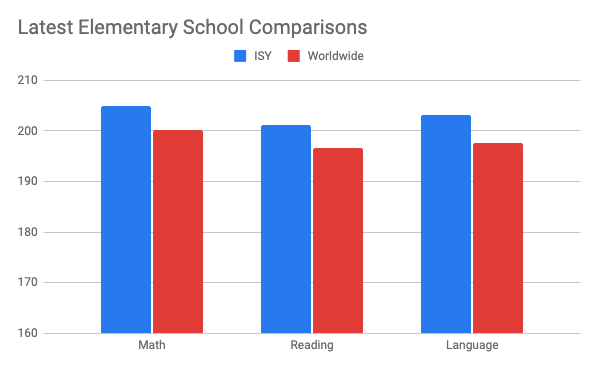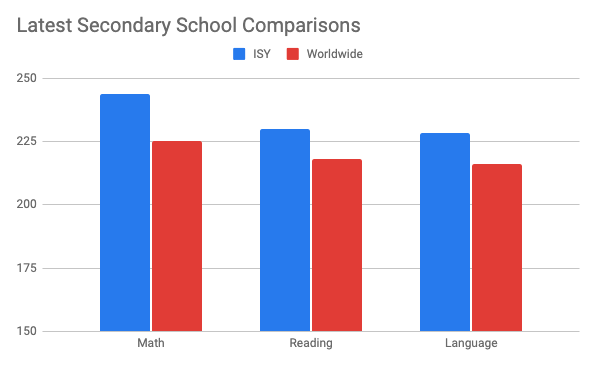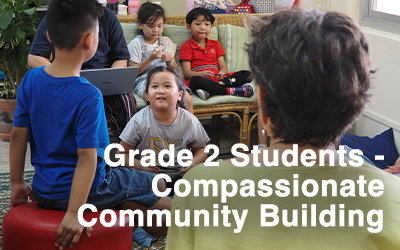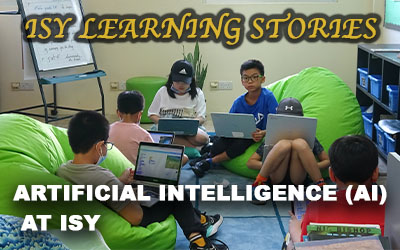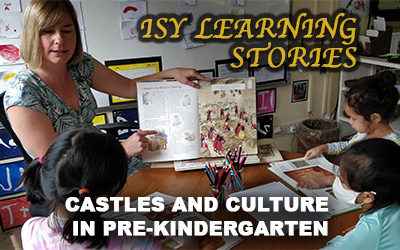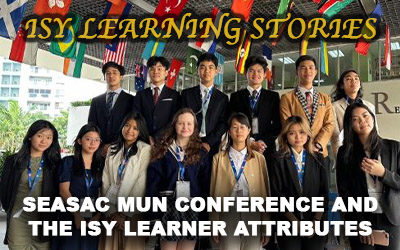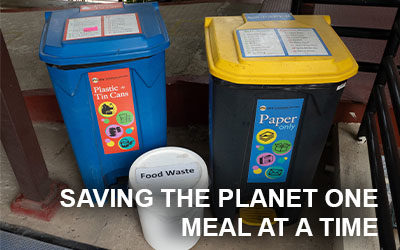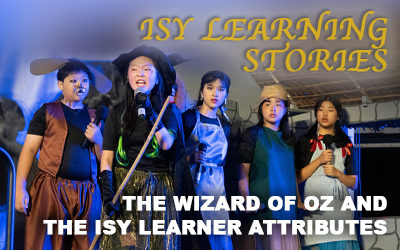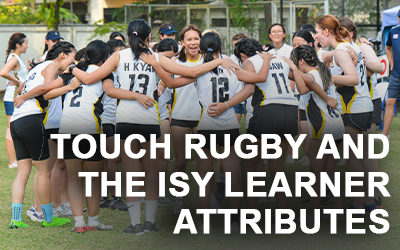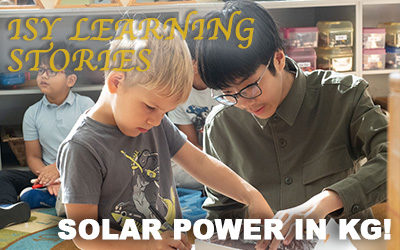Curriculum & Assessment
High academic standards combined with clearly articulated practices for assessment provide the basis of the ISY curriculum. This page provides details about our curriculum and assessment.
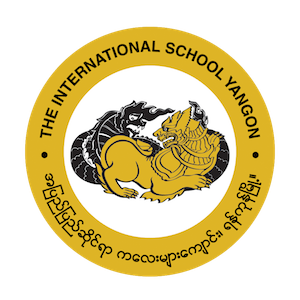
Curriculum
Standards-Based, Outcome-Based Learning
Academic standards, or learning outcomes, are the foundation of the ISY curriculum, and through these standards, teachers identify the skills, knowledge, processes and understandings that are taught and assessed. Instruction is built upon rich, scaffolded learning experiences that facilitate student attainment of the standards, and instructional resources are aligned to learning experiences. The ISY adopted standards provide coherent learning progressions beginning in Pre-Kindergarten continuing through to Grade 12, and they communicate to students, parents, teachers, and administrators what students are expected to learn in each subject area and at each grade level.
Standards alone do not form a curriculum—a curriculum is comprised of all facets of the instructional and assessment process including diagnostic, formative, and summative assessments, learning activities, resources, and classroom environments that support learning.
The subject areas for which ISY has adopted internationally recognized academic standards are: mathematics, English language arts, social studies, science, world languages, physical education, library, health and wellness, visual arts, music, drama, film, and technology.
Each subject’s standards are organized by strands (also known as domains or categories) which describe the major components of the subject. Each strand has a set of standards which describe the skills, knowledge, and understandings students are to demonstrate by the time they finish high school. Standards are typically few in number and broad in scope. Further, for each standard, there are grade level indicators, which are grade-level points of reference that are specific descriptions of knowledge, skill, or understanding.
The ISY Learner Outcomes
We have three ISY Learner Outcomes (ILOs) that we work towards with all of our students. All ISY graduates will be compassionate global citizens, lifelong learners and agents for positive change. In order to achieve this outcome we nurture in all of our students the ISY Learner Attributes. These are compassion, collaboration, communication, courage, creativity, critical thinking and reflection. These attributes are strongly embedded in our curriculum and in everything we do.
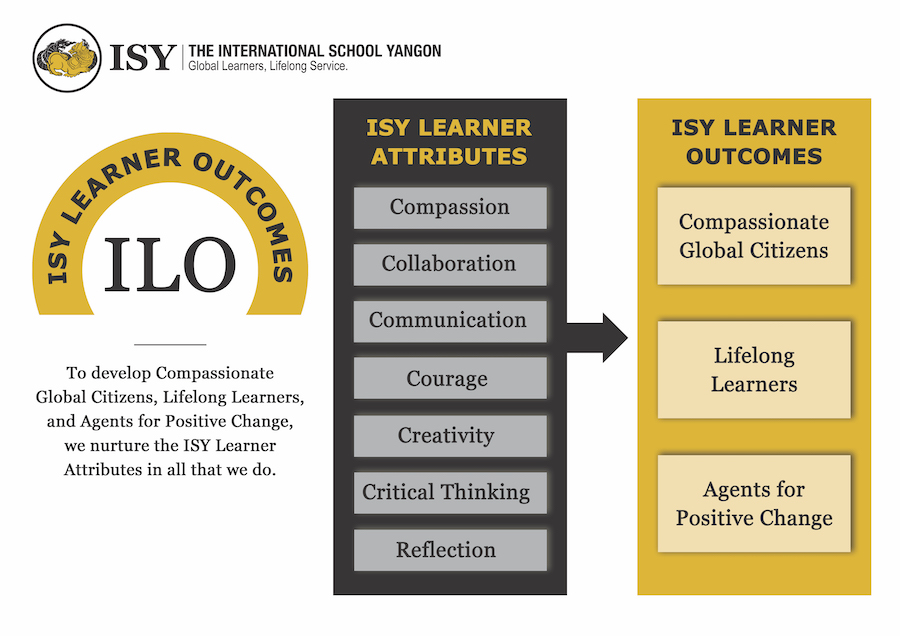
Interdisciplinary Learning
Over the last two years, with the adoption of our compassionate Mission and Vision, a considerable amount of work has gone into developing a curriculum structure that allows for an interdisciplinary approach to learning. An interdisciplinary approach to learning allows students to deepen their learning by making connections between topics, ideas and concepts across different subjects. An example of interdisciplinary learning would be a unit on climate change focusing on courage to do the right thing, the need to collaborate with others to affect change, and thinking critically to come up with innovative solutions to difficult problems. These attributes will be taught in all subjects, with teachers working together to make these connections across the disciplines. A more detailed explanation of Interdisciplinary Learning can be read here.
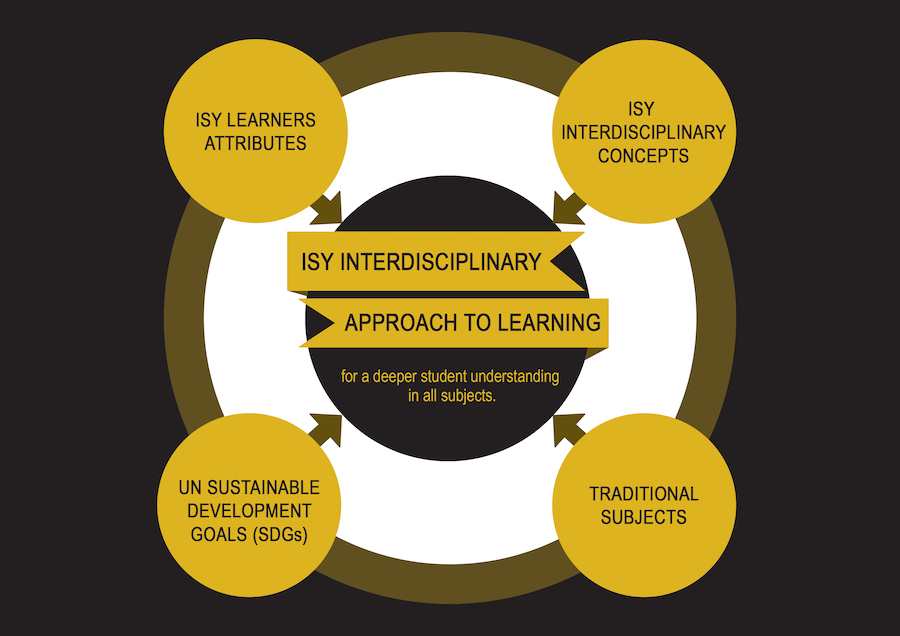
ISY Adopted Standards
English Language Arts
The English Language Arts’ curriculum (Pre-kindergarten through Grade 10) at ISY is based on the Common Core Standards for English Language Arts. These standards “are designed to be robust and relevant to the real world, reflecting the knowledge and skills that young people need for success in college and careers.” They are organized according to the following domains: reading (literature and informational), reading foundations, writing, listening and speaking, and language. The Common Core Standards for English Language Arts expect that:
Students read a wide range of literature from many periods in many genres to build an understanding of the many dimensions (e.g., philosophical, ethical, aesthetic) of the human experience.
- Students read a wide range of print and non-print texts to build an understanding of texts, of themselves, and of the cultures of the world; to acquire new information; to respond to the needs and demands of society and the workplace; and for personal fulfillment. Among these texts are fiction and nonfiction, classic and contemporary works.
- Students apply a wide range of strategies to comprehend, interpret, evaluate, and appreciate texts. They draw on their prior experience, their interactions with other readers and writers, their knowledge of word meaning and of other texts, their word identification strategies, and their understanding of textual features (e.g., sound-letter correspondence, sentence structure, context, graphics).
- Students employ a wide range of strategies as they write and use different writing process elements appropriately to communicate with different audiences for a variety of purposes. Writing types include argument, informational, narrative and research.
- Students use speaking, listening, and information literacy to accomplish specific purposes (e.g., for learning, enjoyment, persuasion, and the exchange of information).
- Students apply knowledge of English language structures, English language conventions (e.g., spelling and punctuation), media techniques, figurative language, and genre to create, critique, and discuss print and non-print texts.
Source: The AERO Framework for English Language Arts (2012) and the National Governors Association Center for Best Practices, Council of Chief State School Officers (2010)
For a complete listing of the Common Core English Language Arts Standards click here.
Visit the Common Core English Language Arts Standards for more information.
Mathematics
The mathematics curriculum is built upon the Common Core Standards for Mathematics. The development of these standards began with research-based learning progressions detailing what is known today about how students’ mathematical knowledge, skill, and understanding develop over time. They emphasize conceptual understanding of key ideas. Further, this set of standards support the following qualities:
Focus and coherence: Fewer standards allow for narrowing and deepening the scope and sequence of concepts and skills.
Fluency: Students are expected to have speed and accuracy with simple calculations.
Understanding: Students are expected to be able to explain and justify mathematical statements and concepts.
Application: Students are expected to use math in various contexts and choose the appropriate concept for application.
Mathematical Practices: A set of aims that strive to develop mathematical processes and proficiencies in students are comprised of the following:
- Make sense of problems and persevere in solving them
- Reason abstractly and quantitatively
- Construct viable arguments and critique the reasoning of others
- Model with mathematics
- Use appropriate tools strategically
- Attend to precision
- Look for and make use of structure
- Look for and express regularity in repeated reasoning
Source: The National Governors Association Center for Best Practices, Council of Chief State School Officers (2010)
To see the complete set of Common Core Math Standards click here.
Visit the Common Core Standards for Mathematics Website for more information.
Science
ISY has completely transitioned to the Next Generation Science Standards (NGSS). Grades 6-10 began using the NGSS standards in the 2015-2016 school year, and the elementary grades gradually transitioned to these standards. Developed by the joint efforts of the National Academy of Sciences, Achieve, the American Association for the Advancement of Science, and the National Science Teachers Association, the Next Generation Science Standards emphasize the following aims and objectives:
- To reflect the interconnected nature of science as it is practiced and experienced in the real world
- Provide a coherent progression of knowledge that gives students the opportunity to learn complex material aimed at overall scientific literacy with instruction focused on a core set of ideas
- To focus on a thorough understanding of content as well as application of content
- By integrating engineering and technology into the standards, students have the opportunity to apply their scientific knowledge to the solutions of practical problems.
- In the longer term, to motivate students to continue study of science and engineering to address major world challenges.
Sources: The Next Generation Science Standards: “APPENDIX A – Conceptual Shifts in the Next Generation Science Standards NGSS” (2013)
To view the NGSS science standards, click here.
Visit the Next Generation Science Standards Website for more information.
Social Studies
ISY follows the AERO standards for social studies. These standards reflect Project AERO’s mission of supporting schools around the world that are independent and international. As a result, the standards are largely free of historically specific information and are built on the following assumptions: that social studies curriculum and instruction should focus on (1) skills and concepts than content (as traditionally understood, such as names, dates, battles, etc.), (2) issues and questions of contemporary relevance to students, and (3) approaches that get students to understand and question how the traditional construction of knowledge reinforces the existing social order. The social studies standards focus on eight big ideas—standards—for learning:
Standard 1 (Time, Continuity, and Change) Students will understand patterns of change and continuity, relationships between people and events through time, and various interpretations of these relationships.
Standard 2 (Connections and Conflict) Students will understand causes and effects of interaction among societies, including trade, systems of international exchange, war, and diplomacy.
Standard 3 (Geography) Students will understand the interactions and relationship between human societies and their physical environment.
Standard 4 (Culture) Students will understand cultural and intellectual developments and interactions among societies.
Standard 5 (Society and Identity) Students will understand social systems and structures and how these influence individual.
Standard 6 (Government) Students will understand why societies create and adopt systems of governance and how they address human needs, rights, responsibilities and citizenship.
Standard 7 (Production, Distribution, and Consumption) Students will understand fundamental economic principles and ways in which economies are shaped by geographic and human factors.
Standard 8 (Science, Technology, and Society) Students will understand how societies have influenced and been influenced by scientific developments and technological developments.
Source: AERO Social Studies Curriculum Framework K-12 Standards And Performance Indicators (2011)
To view the AERO Social Studies Standards click here.
Visit the AERO Social Studies Standards Website for more information.
Physical Education
The physical education program at ISY are based on the Society of Health and Physical Educators (SHAPE) American Standards which “envisions a nation where all children are prepared to lead healthy, physically active lives through health and physical education.”
The following anchor standards are used to build the curriculum:
Standard 1: The physically literate individual demonstrates competency in a variety of motor skills and movement patterns.
Standard 2: The physically literate individual applies knowledge of concepts, principles, strategies and tactics related to movement and performance.
Standard 3: The physically literate individual demonstrates the knowledge and skills to achieve and maintain a health-enhancing level of physical activity and fitness.
Standard 4: The physically literate individual exhibits responsible personal and social behavior that respects self and others.
Standard 5: The physically literate individual recognizes the value of physical activity for health, enjoyment, challenge, self-expression and/or social interaction.
Source: SHAPE American, 2021
To view the SHAPE America Standards, click here.
Core Arts (Visual Arts, Music, Theatre)
The core arts curriculum for visual arts, music, and theatre is based on the National Core Arts Standards. The core arts standards provides “value to the development of every human being. Nurturing our children, then, necessarily means that we must provide all of them—not just those identified as ‘talented’—with a well-rounded education that includes the arts. By doing so, we are fulfilling the college and career readiness needs of our students.”Below are the four overarching standards representing the National Core Arts Standards:
Creating: Conceiving and developing new artistic ideas and work.
Performing/Producing/Presenting:
- Performing (dance, music, theatre): Realizing artistic ideas and work through interpretation and presentation.
- Presenting (visual arts): Interpreting and sharing artistic work.
- Producing (media arts): Realizing and presenting artistic ideas and work.
Responding: Understanding and evaluating how the arts convey meaning.
Connecting: Relating artistic ideas and work with personal meaning and external context.
Source: National Core Arts Standards: A Conceptual Framework for Arts Learning. Visit the National Core Arts Standards to view the standards and for more information.
Technology Integration
ISY uses the International Standards for Technology Education (ISTE). The ISTE standards are the standards for learning, teaching and leading in the digital age and are widely recognized and adopted worldwide. There are six overarching technology standards:
1. Empowered Learner: Students leverage technology to take an active role in choosing, achieving and demonstrating competency in their learning goals, informed by the learning sciences.
2. Digital Citizen: Students recognize the rights, responsibilities and opportunities of living, learning and working in an interconnected digital world, and they act and model in ways that are safe, legal and ethical.
3. Knowledge Constructor: Students critically curate a variety of resources using digital tools to construct knowledge, produce creative artifacts and make meaningful learning experiences for themselves and others.
4. Innovative Designer: Students use a variety of technologies within a design process to identify and solve problems by creating new, useful or imaginative solutions.
5. Computational Thinker: Students develop and employ strategies for understanding and solving problems in ways that leverage the power of technological methods to develop and test solutions.
6. Creative Communicator: Students communicate clearly and express themselves creatively for a variety of purposes using the platforms, tools, styles, formats and digital media appropriate to their goals.
7. Global Collaborator: Students use digital tools to broaden their perspectives and enrich their learning by collaborating with others and working effectively in teams locally and globally.
Source: ISTE Standards for Technology (2016)
Visit the International Standards for Technology Education Website for more information.
World Languages
World Languages
Our Mandarin and French programs (World Languages B) follow the American Council for Teachers of Foreign Language (ACTFL) Readiness Standards for World Languages (2015) and the NCSSFL-ACTFL Can-Do Statements for Learning (2013). Each of these documents outline outcomes for students learning an additional language and are part of a coordinated system. The Readiness Standards for World Languages provide a broad set of overarching standards while the Can-Do Statements for Learning are progress indicators specific to communication and reflect a continuum of language learning.
There are five overarching standards for language learning:
1. Communication: Communicate effectively in more than one language in order to function in a variety of situations and for multiple purposes.
2. Cultures: Interact with cultural competence and understanding.
3. Connections: Connect with other disciplines and acquire information and diverse perspectives in order to use the language to function in academic and career-related situations.
4. Comparisons: Develop insight into the nature of language and culture in order to interact with cultural competence.
5. Communities: Communicate and interact with cultural competence in order to participate in multilingual communities at home and around the world.
The communication standards group learning according to these three described modes of communication:
Interpersonal: Learners interact and negotiate meaning in spoken conversations to share information, reactions, feelings, and opinions. (unrehearsed conversational language)
Interpretive: Learners understand, interpret, and analyze what is heard, read, or viewed on a variety of topics. (listening, reading, and viewing comprehension)
Presentational: Learners present information, concepts, and ideas to inform, explain, persuade, and narrate on a variety of topics using appropriate media and adapting to various audiences of listeners, readers, or viewers. (rehearsed writing and speaking for an audience)
Source: World-Readiness Standards for Learning Languages (2015) and the NCSSFL-ACTFL Can-Do Statements for Learning (2013)
To view the ACTFL World Readiness Standards click here. To view the Can-Do Statements for Learning, click here.
Visit the ACTFL Standards and Can-Do Statements Website for more information.
Burmese Language
In Grades 1 – 5 students have a cultural class which includes some elements of Burmese language.
In Grades 9 and 10 there is an elective Burmese language class for native speakers.
In Grades 11 and 12 students can take an IB diploma course in Burmese language.
Health & Wellness
The standards for Health and Wellness are adopted from Washington State—Washington State K-12 Health and Physical Education Standards (2016)—and were developed with the intent to help students understand how to achieve and maintain good health and well being for a lifetime. The health standards are organized into six core domains: wellness, safety, nutrition, sexual health, social emotional health, and substance use and abuse. The broad accompanying standards for each domain are as follows:
Standard 1: Students will comprehend concepts related to health promotion and disease prevention to enhance health.
Standard 2: Students will analyze the influence of family, peers, culture, media, technology, and other factors on health behaviors.
Standard 3: Students will demonstrate the ability to access valid information and products and services to enhance health.
Standard 4: Students will demonstrate the ability to use interpersonal communication skills to enhance health and avoid or reduce health risks.
Standard 5: Students will demonstrate the ability to use decision-making skills to enhance health.
Standard 6: Students will demonstrate the ability to use goal-setting skills to enhance health.
Standard 7: Students will demonstrate the ability to practice health-enhancing behaviors and avoid or reduce health risks.
Standard 8: Students will demonstrate the ability to advocate for personal, family, and community health.
Source: Washington State K-12 Health and Physical Education Standards (2016)
To view and learn more about the Washington Health and Physical Education Learning Standards, click here.
English as an Additional Language
The English as an Additional Language program at ISY builds its curriculum upon the California English Language Development Standards (2012). These standards are aligned to the Common Core English Standards to help English language learners develop their skills alongside the expectations put forth in the mainstream English classroom. The standards, are organized by three stages of language development with expectations outlined at each grade level. This organization represents English language development as a continuum of increasing proficiency. The levels are Emerging, Expanding, and Bridging. Expectations are further defined and identified by:
Three Modes of Communication:
- Collaborative (engagement in dialogue with others)
- Interpretive (comprehension and analysis of written and spoken texts)
- Productive (creation of oral presentations and written texts)
And two dimensions of Knowledge of Language:
- Metalinguistic Awareness: The extent of language awareness and self‐monitoring students have at the level
- Accuracy of Production: The extent of accuracy in production ELS can be expected to exhibit at the level
Source: “Overview of the California English Language Development Standards and Proficiency Level Descriptors” (2012)
To view the “Overview of the California English Language Development Standards and Proficiency Level Descriptors”, click here.
To view individual grade level expectations for English as an Additional Language, click here.
Film
The ISY film standards are unique to ISY, but are inspired by the National Film Study Standards. These standards promote students to become informed critics of the moving image and to produce film art. The standards engage students in viewing films analytically and critically enabling students to develop a thorough knowledge of filmmaking.
- Film Analysis: Students develop a vocabulary for interpreting the production values of film. Students analyze preproduction elements of composition, design and narrative structures and post production elements of editing and sound.
- Film Production: Students understand auteur theory and produce films acting in various production roles. Students explore the filmmaking process of pre-production, production and postproduction.
- Historical and Cultural Context: Students understand how society and culture can be reflected in films. Students research and analyze the ways in which historical events and social issues influence a film’s making.
Source: National Film Standards/The Film Foundation (2004)
To view the ISY Film Standards, click here.
Assessment
Purpose of Assessment & Grading
ISY has clearly articulated practices and beliefs for assessment and grading. Framing these beliefs, are defined purposes for assessment and grading:
- The purpose of assessment at ISY is to improve student learning and to inform teachers’ instructional practices.
- The purpose of grades is to communicate student achievement of standards and the ISY Expected Schoolwide Learner Results (ESLRs), including the IB aims and objectives and the IB Learner Profile, to students, parents, school administrators, other institutions and employers.
Assessment and Practices
Classroom assessments at ISY are based on the knowledge, skills, and learning targets derived from the ISY adopted standards displayed above. Students are given formative assessments, or assessments for learning, which provide them with valuable feedback. For teachers, formative assessments provide information to help inform instructional decision-making as learning occurs. Students use feedback on formative assessments to improve and revise their work and learning. Summative assessments typically occur at the end of an instructional unit and provide evidence of student achievement for the purpose of making a judgment about student proficiency.
In a standards-based system, behaviors that support learning, such as work habits, effort, responsibility, and attitudes are judged separately so that academic grades are accurate and reflect how a student performs and achieves in relation to the knowledge, skills, and understandings set forward by the standards. Such nonacademic factors are of equal importance to the development, success, and achievement of students and their learning, thus, performance in these areas of student learning are assessed, tracked, and reported distinctly from academic achievement.
Follow the link, Assessment Guide, for more details about ISY’s assessment and grading practices.
External Schoolwide Assessments
ISY utilizes internal and external assessment data to assist in monitoring student learning, student progress and schoolwide programs. Longitudinal trends that mark areas of strength and areas to improve are identified to guide schoolwide action planning for ongoing, continuous improvement.
When using assessment results to evaluate student learning, ISY considers several reference or data points that, together, provide a complete profile of a student’s skills, abilities, and knowledge.
MAP Growth (Measures of Academic Progress)
What are MAP assessments?
MAP assessments are online adaptive assessments that provide useful data in developing a fair and accurate assessment of student academic achievement and growth. MAP Growth uses a scale to measure what students know, regardless of their grade level. It also measures growth over time, allowing us to track our students throughout the school year and across multiple years.
Why do we do MAP testing?
The academic achievement and growth data obtained from MAP assessments forms one part of a student’s data profile. MAP assessment data is combined with data gathered by classroom teachers to ensure that we have a fair and accurate understanding of each student’s academic and learning needs. This understanding of student academic and learning needs then guides teacher planning and instructional practices in meeting the needs of individual students.
As well as providing important data that guides planning and instruction for individual students, MAP data also guides our continuous school improvement efforts. We can use school, grade and subject level MAP data to identify which academic areas we need to focus our improvement efforts on.
How do we do MAP testing?
Our processes around MAP testing at ISY are designed to fit the purpose of our students sitting the tests and our commitment to fair and accurate assessment practices.
There are two MAP assessment sessions in an academic year:
- The end of August / beginning of September.
- Grade 1: Reading and Mathematics
- Grades 2 and 3: Reading, Mathematics, and Language
- Grades 4, 5, 6, 7, 8 and 9: Reading, Mathematics, Language, and Science
- The end of January / beginning of February.
- Grade 1: Reading and Mathematics
- Grades 2 and 3: Reading, Mathematics, and Language
- Grades 4, 5, 6, 7, 8 and 9: Reading, Mathematics, and Language
We test our students at the beginning of the school year to provide us with data as to the academic achievement levels that our students are starting the year with. This data then guides teacher planning and instructional practices. We also use this data to track student academic growth from the beginning of the previous school year.
We test our students again in the middle of the year to track our students’ academic achievement and growth from the beginning of the year. Again,This data then guides teacher planning and instructional practices for the remaining months of the school year.
Student MAP data is shared, along with other teacher collected student achievement data, with parents during parent conferences. However, if you would like to have access to your child(ren)’s assessment data prior to a conference, please email Mike Simpson, our Secondary School Principal at msimpson@isyedu.org and he will be happy to forward that information to you. Student MAP reports are also posted to Powerschool after conferences.
PSAT
All Grade 10 students participate in the Pre-Scholastic Aptitude Test (PSAT) to help prepare for the SAT and to identify strengths and areas for improvement. Students are assessed on reading, writing and language, and mathematics skills. All questions are in the multiple-choice format.
The reading test measures the following skills:
- Citing evidence to support a conclusion
- Identifying how authors use evidence to support their claims
- Using context clues to determine meanings of words
- Determining how an author’s word choice affects the meaning, style, or tone of a text
- Analyzing history, social studies, and science texts (to examine claims, interpret data, and make inferences)
The writing and language test measures the following skills:
- Supporting arguments with relevant information and ideas
- Developing a claim for an argument
- Revising text for improved word choice, sentence fluency, organization, and optimal impact and expression of ideas
- Using knowledge of English language conventions to edit text for correct punctuation, subject-verb agreement, parallelism, comma usage, sentence structure, and correct verb tense
The mathematics test measures the following areas and skills in math:
- Mastery of linear equations and systems
- Problem solving and data analysis
- Procedural flexibility and accuracy
For more information about the PSAT, follow this link.
Learning Story Blog Posts
ISY Learning Story – Grade 2 Students Compassionate Community Building
Grade 2 students embrace our ISY Mission, Vision, learner attributes, strategic themes, and the UN SDGs through Service Learning.
ISY Learning Story – AI at ISY
ISY has been actively exploring innovative ways to harness the capabilities of ChatGPT, to enhance the quality of their lessons.
The Community Library Project
Our new Community Library will be a wonderful contribution to our school’s commitment to nurturing a sense of Belonging and Internationalism.
Castles and Culture in Pre-Kindergarten
Read about how our Pre-Kindergarten class has been learning about castles by connecting this topic to different cultures.
ISY Students Share their MUN Experience
SEASAC Model United Nations (MUN) Conference in Vietnam and how our ISY Learner Attributes enriched their MUN experience.
Saving the planet one meal at a time
Read about how ISY went from learning about the importance of food choices to an all vegetarian campus. From meatless Mondays to no meat at the Fun Fair.
The Wizard of Oz and the ISY Learner Attributes
Interviews with cast members of the Wizard of Oz to see how the ISY Learner Attributes apply to putting on a great show.
Touch Rugby and the ISY Learner Attributes
Mr. Simpson interviews the captain of our Touch Rugby team to see how the ISY Learner Attributes come through during an athletics tournament.
Kindergarten and Renewable Resources
Read how KG students really wanted to understand all about how solar power works and then experimented with the help of some 10th Graders.
The International School Yangon
20 Shwe Taungyar Street
Bahan Township
Yangon, Myanmar
+95 (0) 9 880 441 040

